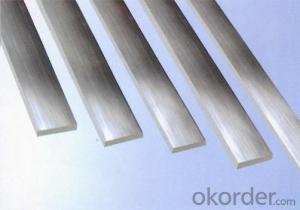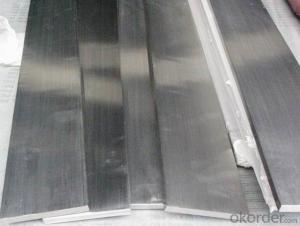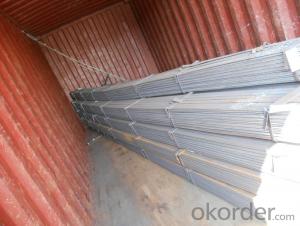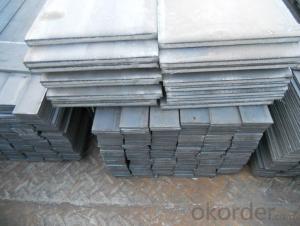high quality flat bar
- Loading Port:
- China Main Port
- Payment Terms:
- TT OR LC
- Min Order Qty:
- -
- Supply Capability:
- -
OKorder Service Pledge
OKorder Financial Service
You Might Also Like
Product Description:
Product Description:
Specification of Mild Steel Flat Bar
Commodity: Mild Steel Flat Bar
Standard: GB;JIS
Material: Q195-235;SS400
Brand name: FLATSPACE
Origin place: China
Thickness: 3mm-30mm
Width:20mm-200mm
Length: Max 12m
Certification: SGS/BV
Chemical composition of Q235
Alloy No | Grade | Element(%) | ||||
C
| Mn
| S
| P
| Si
| ||
Q235
|
B
|
0.12—0.20 |
0.3—0.7 |
≤0.045 |
≤0.045
|
≤0.3
|
Physical properties of Q235
Alloy No | Grade | Yielding strength point(Mpa) | Tensile strength (Mpa) | Elongation after fracture(%) | ||||||
Thickness (mm) | Thickness (mm) | |||||||||
≤16 | >16--40 | >40--60 | >60--100 |
| ≤16 | >16--40 | >40--60 | >60--100 | ||
≥ | ≥ | |||||||||
Q235 |
B |
235 |
225 |
215 |
205 |
375--500 |
26 |
25 |
24 |
23 |
Usage/Applications of Mild Steel Flat Bar
Widely used for construction, Machinery manufacturing, Iron tower steel structure, Shipbuilding; Steel grating, Staircase, Bridge, Viaduct, Railway spare parts, Boilers making etc.
Packaging & Delivery of Mild Steel Flat Bar
Packaging Details: The Mild Steel Flat Bars are packed in bundles and loaded in 20 feet/40 feet container, or shipped by bulk cargo ,also we can do as customer's requirements.
Delivery Details:30~45 days upon the receipt of buyer payment by T.T. or L/C.
Production Flow of Mild Steel Flat Bar
The Mild steel flat bar is made through three processes:
1.Feeding the material: Feeding the row material (the steel plate) to Slitting Line.
2.Slitting:The steel plate would be slitted into expected width by lengthways cutter.
3. Leveled and cutting: The plat bar would be ground into level by the grinder and then cut into required length
- Q:Are steel flat bars available in different lengths and thicknesses?
- Yes, steel flat bars are available in different lengths and thicknesses. The lengths can vary depending on the supplier or manufacturer, but common lengths include 6 feet, 8 feet, and 10 feet. Additionally, steel flat bars can come in a range of thicknesses, such as 1/8 inch, 1/4 inch, 3/8 inch, and so on. The availability of different lengths and thicknesses allows for versatility in various construction and manufacturing applications, ensuring that there is a suitable option for different project requirements.
- Q:Earthing flat steel, width, overlap face, bolt, big country net
- There is no requirement for the width of the ground steel, the width of the joint surface and the bolt. As long as you lap the joint, the corresponding screw can also ensure the electrical connection and the mechanical strength.
- Q:Can steel flat bars be used for making telecommunications industry equipment?
- Yes, steel flat bars can be used for making telecommunications industry equipment. Steel is a commonly used material in the manufacturing of various equipment due to its strength, durability, and cost-effectiveness. Steel flat bars can be used in the construction of equipment racks, supports, brackets, and frames for housing telecommunications equipment such as servers, switches, routers, and antennas. The flat shape of the bars allows for easy fabrication and customization to meet specific design requirements. Additionally, steel is resistant to corrosion, which is crucial for telecommunications equipment that may be exposed to harsh environmental conditions. Overall, steel flat bars are a suitable choice for constructing telecommunications industry equipment.
- Q:Can steel flat bars be used in architectural applications?
- Certainly, architectural applications do make use of steel flat bars. These bars possess versatility and durability, rendering them appropriate for a range of architectural purposes. They find utility in constructing structural components like beams, columns, and braces, bestowing stability and fortitude upon buildings. Furthermore, steel flat bars can confer an ornamental touch, serving as handrails, balustrades, and cladding, infusing architectural designs with a contemporary and polished appearance. With their exceptional tensile strength and resistance to corrosion, architects can rely on steel flat bars as a trustworthy option that harmonizes functionality and aesthetics in their projects.
- Q:Can steel flat bars be bent or shaped?
- Yes, steel flat bars can be bent or shaped to a certain extent using specialized tools and techniques such as a hydraulic press or a bending machine.
- Q:Are steel flat bars prone to rusting?
- Steel flat bars have a tendency to rust. The main component of steel is iron, which is highly vulnerable to rusting when it comes into contact with moisture and oxygen over time. Rust occurs as a result of a chemical reaction known as oxidation, where iron combines with oxygen to form iron oxide. This process undermines the structural integrity of the steel and can lead to decay and eventual failure if left unattended. To prevent or reduce the occurrence of rust, steel flat bars are often treated with protective coatings like paint, galvanization, or powder coating. Regular upkeep and proper storage, such as keeping the steel dry and away from moisture, also aid in preventing rust.
- Q:Can steel flat bars be used for support beams or columns?
- Yes, steel flat bars can be used for support beams or columns. Steel flat bars are commonly used in construction and engineering projects for their strength and durability. They can provide structural support and stability when properly designed and installed.
- Q:What are the common standards or specifications for steel flat bars?
- Steel flat bars adhere to various common standards and specifications to guarantee uniformity and excellence in their production and utilization. Some well-known standards are as follows: 1. ASTM A36/A36M: This standard sets out the prerequisites for carbon structural steel, encompassing steel flat bars. It covers different measurements, chemical composition, mechanical properties, and tolerances. 2. ASTM A108: This specification outlines the requirements for carbon steel bars, which include flat bars, utilized for general structural purposes. It encompasses various grades and classes of carbon steel, along with their chemical composition, mechanical properties, and tolerances. 3. ASTM A666: This standard deals specifically with the requirements for austenitic stainless steel flat bars. It provides specifications for chemical composition, mechanical properties, dimensions, and surface finishes. 4. EN 10058: This European standard defines the dimensions, tolerances, and technical delivery conditions for hot-rolled flat steel bars. It covers different steel grades and offers guidelines for the manufacturing process and surface quality. 5. JIS G3101: This Japanese standard establishes general requirements for hot-rolled steel plates, sheets, and strips, including flat bars. It includes specifications for chemical composition, mechanical properties, dimensions, and tolerances. It is crucial to note that specific industries or applications may impose additional requirements or standards for steel flat bars. For instance, the construction industry often refers to particular local building codes or standards, while the automotive industry may have its own exclusive specifications. Hence, considering the intended use and consulting the relevant standards and specifications are essential to ensure compliance and suitability for a specific project or application.
- Q:What is a steel flat bar?
- A steel flat bar is a long, rectangular-shaped metal piece made of steel that has a flat surface and straight edges. It is commonly used in construction, manufacturing, and various industries for structural support, fabrication, and general-purpose applications.
- Q:Can steel flat bars be used for making lifting or rigging equipment?
- No, steel flat bars are not suitable for making lifting or rigging equipment as they lack the necessary strength and load-bearing capacity required for such purposes. It is recommended to use specially designed and certified lifting or rigging equipment that meets safety standards.
1. Manufacturer Overview |
|
|---|---|
| Location | |
| Year Established | |
| Annual Output Value | |
| Main Markets | |
| Company Certifications | |
2. Manufacturer Certificates |
|
|---|---|
| a) Certification Name | |
| Range | |
| Reference | |
| Validity Period | |
3. Manufacturer Capability |
|
|---|---|
| a)Trade Capacity | |
| Nearest Port | |
| Export Percentage | |
| No.of Employees in Trade Department | |
| Language Spoken: | |
| b)Factory Information | |
| Factory Size: | |
| No. of Production Lines | |
| Contract Manufacturing | |
| Product Price Range | |
Send your message to us
high quality flat bar
- Loading Port:
- China Main Port
- Payment Terms:
- TT OR LC
- Min Order Qty:
- -
- Supply Capability:
- -
OKorder Service Pledge
OKorder Financial Service
Similar products
New products
Hot products
Hot Searches
Related keywords




























